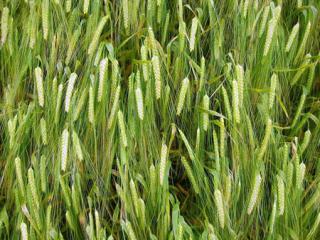Integrated Disease Management in Spring Barley
Published on 16 December 2014 in Climate, water and energy , Ecosystems and biodiversity , Food, health and wellbeing

Introduction
Intergrated Disease Management (IDM) could help greatly reduce the volume of crops lost to disease in Scotland, contributing to our future food security. It works by integrating plant resistance, fungicides, cultural methods such as appropriate use of fertilisers, and newer, innovative approaches, to provide effective and sustainable disease control.
In Scotland, barley is the second most important crop after grass, with nearly 300,000 ha grown in 2012, with a net value of £315 million. Diseases represent a major constraint to barley production globally, despite considerable effort to control the pathogens responsible. The ability of pathogens to overcome host resistance, development of pathogen insensitivity to fungicides, and the increasing importance of pathogens thought previously to be of minor significance, means that diseases will continue to pose a threat to global barley production.
These constraints, coupled with increasing legislation aimed at protecting the environment, have led to increased efforts to find more sustainable approaches to disease control. Such approaches clearly need to balance protecting the crop from threats such as diseases, pests and weeds, with the need to minimise environmental damage, and requires an integrated approach to crop protection.
IDM represents such an approach and is a continuously improving process in which innovative solutions are integrated and adapted locally by growers. By offering a broad spectrum, integrated approach to disease control, IDM will contribute to reducing reliance on pesticides in agricultural systems.
Key Points
- Continuing research at SRUC and the James Hutton Institute (JHI) is focused on developing integrated approaches to disease control in a range of crops, including spring barley. Such Integrated Disease Management (IDM) systems combine biological, cultural and chemical control methods in a way that minimises economic, environmental and health risks.
- Approaches under examination include triggering the plant’s existing defences, improving the ability of barley to tolerate disease, identifying new sources of host resistance, and understanding resistance deployment strategies (e.g. use of variety mixtures), identifying novel target for development of new fungicides, and improved understanding of the barriers that exist to the adoption of integrated management approaches from growers and end-users.
Research Undertaken
RESAS-funded research at the JHI and SRUC has been aimed at developing an integrated approach for disease management in barley in which new methods may be combined with existing measures to improve the efficacy of control in the long-term.
Advances have been made in genetic mapping of plant resistance (R) genes and in identifying novel sources of genes in wild barley populations and land races, while selection techniques are being used to increase the durability of resistance.
Elicitors are compounds which can help the plant to activate its own in-built defences. Research is looking at using these in combination with fungicides to improve disease control, thereby reducing the need for chemical treatments. This means that pathogens should build up resistance to fungicides much more slowly, extending the life of fungicides as well as providing effective disease control.
Work is also underway to identify traits which help the plant to avoid infection, or if they become infected, to help the plant cope with disease without compromising yield. The possibility of using mixtures of varieties in the same field is also being examined as a means of reducing the spread of pathogens and improving disease control.
Methods are also being developed to allow farmers to assess the risk of damage to the crop from disease in order to determine whether fungicide treatment is required. Finally, research is examining the barriers which exist to the adoption of integrated management approaches by growers and whether uptake of IDM might require policy incentives from government.
Policy Implications
- Food security – the research will deliver improved methods for disease forecasting and detecting pathogens in the crop, together with disease control methods which are both effective and durable, with less impact on the environment.
- Common Agricultural Policy – the development of more durable and environmentally-benign disease control methods will contribute towards the proposed ‘greening’ of direct payments, by strengthening the environmental sustainability of agriculture. [The EC is proposing to spend 30% of direct payments specifically for the improved use of natural resources].
- Water – the research will deliver disease control methods requiring less use of fungicides, thereby reducing the likelihood of runoff and pollution of water courses.
- National Action Plan is a requirement under EU law to establish a framework for community action to achieve the sustainable use of pesticides. This includes a requirement to adopt the principles of IDM, ensuring that ‘professional users of pesticides switch to practices and products with the lowest risk to human health and the environment among those available for the same pest problem’.
Authors
Professor Dale Walters, SRUC dale.walters@sruc.ac.uk
Dr Fiona Burnett, SRUC fiona.burnett@sruc.ac.uk
Professor Adrian Newton, James Hutton Institute adrian.newton@hutton.ac.uk
Topics
Climate, water and energy , Ecosystems and biodiversity , Food, health and wellbeing







